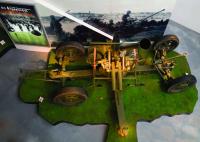Bofors L60 light anti-aircraft gun
Published in 20th-century / Contemporary History, Features, Issue 3 (May/June 2011), The Emergency, Volume 19
The Bofors L60 light anti-aircraft gun on display in the Soldiers and Chiefs exhibition at the National Museum of Ireland, Collins Barracks—one of two surviving that opened fire on unauthorised aircraft during the Emergency
The year 1941 started ominously in Ireland with a number of bombings by German planes from 1 to 3 January, which many feared were a prelude to an invasion. When compared to what was happening in Britain the attacks were small, carried out by one or two planes; three people were killed in Borris, Co. Carlow. Four months later, on 15–16 April and 4–5 May, several hundred German bombers dropped incendiaries and high explosives on Belfast, apparently aiming for the Harland and Wolff shipyard and the Short Brothers aviation factory. Over 1,100 civilians died and half the houses in the city were destroyed. The Northern Irish authorities asked Taoiseach Eamon de Valera for assistance, and 70 fire-fighters from Dublin, Dún Laoghaire, Drogheda and Dundalk volunteered to go to Belfast to help fight the fires.
Then on 31 May 1941, during a bank holiday weekend, a single German bomber dropped four bombs across Dublin, killing 29 people and injuring 90. The evidence suggests that this was an accident, caused by a German bomber mistaking Dublin for a British city or responding to fire from Irish Army anti-aircraft guns.

A German incendiary bomb dropped on Belfast in April or May 1941. (National Museum of Ireland; Ulster Museum)
On display in the Soldiers and Chiefs exhibition at the National Museum of Ireland, Collins Barracks, is a Bofors L60 light anti-aircraft gun, one of two surviving weapons that opened fire on unauthorised aircraft during the Emergency. The Irish Defence Forces purchased four of these guns from Britain, where they were manufactured under licence from the Swedish parent company, in June 1939 and a further two in May 1943. During the Emergency there were two Bofors at Baldonnel, where the Air Corps were based, and at the Hibernian School (now St Mary’s Hospital) in the Phoenix Park. Later two of the guns were moved to Collinstown (now Dublin Airport). The gunners were a front-line unit and regularly opened fire on German and British planes when they flew over Dublin. From 1939 to 1943, 217 rounds of ammunition were fired by the 40mm anti-aircraft guns, and on the night of the North Strand bombings the gun on display fired from Collinstown at a German plane at 1.30am. In addition to Bofors there was the larger, 3.7in. anti-aircraft gun, stocks of which went from two in 1940 to eighteen by 1943.
There were no further attacks on Ireland, and with the German invasion of Russia in the summer of 1941 attacks on Britain ended until the V1s (flying bombs) and V2s (rockets) in the summer of 1944. HI
Lar Joye is curator of military history at the National Museum of Ireland (Decorative Arts and History).


















